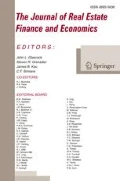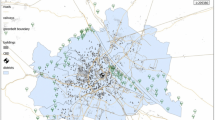Abstract
Hedonic price models for determining marginal implicit prices of open-space amenities and nonresidential land use were estimated using housing data from the census. Alternative model specifications were compared to evaluate the effects of aggregating land-use data by alternative levels of census geography as well as the use of different sample sizes of census blocks. It was determined that land use is best aggregated at the block group level and that entire populations or very large sample sizes of census blocks should be used with hedonic models.
Similar content being viewed by others
References
Benson, E. D., J. L. Hansen, A. L. Schwartz, and G. T. Smersh. (1998). “Pricing Residential Amenities: The Value of a View,” Journal of Real Estate Economics and Finance 16(1), 55–73.
Blomquist, G., and L. Worley. (1981). “Hedonic Prices, Demands for Urban Housing Amenities, and Benefit Estimates,” Journal of Urban Economics 9, 212–221.
Butler, R. V. (1982). “The Specification of Hedonic Indexes for Urban Housing,” Land Economics 58(1), 96–108.
Cao, T. V., and D. C. Cory. (1981). Mixed Land Uses and Residential Property Values in the Tucson Metropolitan Region: Implications for Public Policy. Technical Bulletin No. 241, Agricultural Experiment Station, University of Arizona.
Dombrow, J., J. R. Knight, and C. F. Sirmans. (1997). “Aggregation Bias in Repeat Sales Indexes,” Journal of Real Estate Economics and Finance 14(1), 75–88.
Doss, C. R., and S. J. Taff. (1996). “The Influence of Wetland Type and Wetland Proximity on Residential Property Values,” Journal of Agricultural and Resource Economics 21(1), 120–129.
Freeman, M. A. (1979). “Hedonic Prices, Property Values and Measuring Environmental Benefits: A Survey of the Issues,” Scandinavian Journal of Economics 81(2), 154–173.
Geoghegan, J., L. A. Wainger, and N. E. Bockstael. (1997). “Spatial Landscape Indices Hedonic Framework: An Ecological Economics Analysis Using GIS,” Ecological Economics 23, 251–264.
Goodman, A. C. (1977). “A Comparison of Block Group and Census Tract Data in a Hedonic Housing Price Model,” Land Economics 53(4), 483–487.
Halvorsen, R., and H. Pollakowski. (1981). “Choice of Functional Form for Hedonic Price Equations,” Journal of Urban Economics 10, 37–49.
Judd, D. G. (1980). “The Effects of Zoning On Single Family Residential Property Values: Charlotte, North Carolina,” Land Economics 56(2), 142–154.
King, D. A., J. L. White, and W. W. Shaw. (1991). “Influence of Urban Wildlife Habitats on the Value of Residential Properties.” In L. W. Adams and D. L. Leedy (eds.), Wildlife Conservation in Metropolitan Environments: A National Symposium on Urban Wildlife. NIUW Symposium Series 2, National Institute for Urban Wildlife, Columbia, MD.
Li, M., and J. Brown. (1980). “Micro-Neighborhood Externalities and Hedonic Housing Prices,” Land Economics 56(2), 125–141.
McMillen, D. P., and J. F. McDonald. (1989). “Selectivity Bias in Urban Land Value Functions,” Land Economics 65(4), 34–351.
Pace, K. R., R. Barry, and C. F. Sirmans. (1998). “Spatial Statistics and Real Estate,” Journal of Real Estate Economics and Finance 17(1) 5–13.
Palmquist, R. B. (1992). “Valuing Localized Externalities,” Journal Urban Economics 31(1), 59–68.
Shaw, W., J. Burns, and K. Stenberg. (1986). Wildlife Habitats in Tucson: A Strategy for Conservation. unpublished report, University of Arizona.
Speyrer, J. F. (1989). “The Effect of Land-Use Restrictions on Market Values of Single-Family Homes in Houston,” Journal of Real Estate Economics and Finance 2(2) 117–130.
Vaughn, R. J. (1981). “The Value of Urban Open Space,” Research in Urban Economics 1, 103–130.
Worden, M., and D. Dekok. (1991). Metropolitan Tucson Land Use Study (4th quarter, 1991). Report of the Drachman Institute, Tucson, AZ.
Author information
Authors and Affiliations
Rights and permissions
About this article
Cite this article
Shultz, S.D., King, D.A. The Use of Census Data for Hedonic Price Estimates of Open-Space Amenities and Land Use. The Journal of Real Estate Finance and Economics 22, 239–252 (2001). https://doi.org/10.1023/A:1007895631071
Issue Date:
DOI: https://doi.org/10.1023/A:1007895631071




